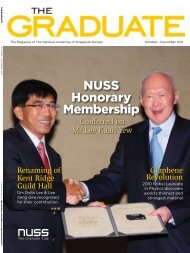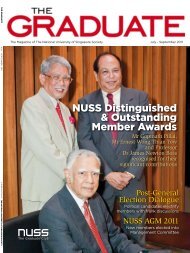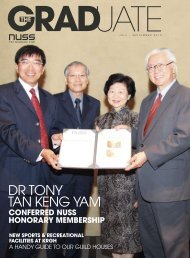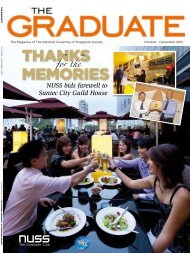The view from singapore with British High Commissioner to ... - NUSS
The view from singapore with British High Commissioner to ... - NUSS
The view from singapore with British High Commissioner to ... - NUSS
Create successful ePaper yourself
Turn your PDF publications into a flip-book with our unique Google optimized e-Paper software.
cover s<strong>to</strong>ry<br />
In a survey of 6,000 respondents<br />
on marriage and parenthood<br />
conducted by the Ministry of Social<br />
and Family Development (MSF),<br />
formerly known as Ministry of<br />
Community Development, Youth and<br />
Sports (MCYS), 80 percent of the<br />
married want two <strong>to</strong> three children<br />
but the cost of bringing up children<br />
and the lack of supportive work<br />
policies have made it challenging for<br />
them <strong>to</strong> have bigger families. On the<br />
other hand, 85 percent of singles want<br />
<strong>to</strong> get married but cited difficulty in<br />
finding a suitable partner. This is in<br />
part due <strong>to</strong> preoccupation <strong>with</strong> their<br />
career as the survey result reflected.<br />
<strong>The</strong> other obstacle is the higher<br />
education level of women. According<br />
<strong>to</strong> the book, <strong>The</strong> Greying of Asia, men<br />
avoid marrying up, that is, marrying<br />
women who have higher education<br />
levels than themselves.<br />
To address the cost of raising a<br />
family, the Government has rolled<br />
out several incentives such as the<br />
Baby Bonus Scheme, the Child<br />
Development Credit, the Parenthood<br />
Tax Rebate and the Working mother’s<br />
child relief. Drawing <strong>from</strong> his<strong>to</strong>ry,<br />
incentives like the ‘Have Three or<br />
More If You can Afford’ policy in<br />
1980s did not work. In 2011, there<br />
were about 36,000 babies born - a<br />
big shortfall <strong>from</strong> our target of 60,000<br />
births each year <strong>to</strong> maintain our<br />
population size. If couples back then<br />
were not enticed by the rewards for<br />
procreation, the current cohort will be<br />
harder <strong>to</strong> convince.<br />
As such, Mr Lee Kuan Yew<br />
has commented extensively that<br />
Singapore has <strong>to</strong> accept more<br />
immigrants if Singaporeans do not<br />
start having more babies. However,<br />
even if we can better manage our<br />
concerns over foreigners, there is<br />
still the issue of emigration which<br />
also contributes <strong>to</strong> our ageing<br />
population. Statistically every year,<br />
1,200 Singaporeans give up their<br />
citizenship. Can we then prevent<br />
further outflow of people?<br />
“I am not sure it is possible (given<br />
that we are a democratic country) or<br />
even desirable <strong>to</strong> prevent people <strong>from</strong><br />
going abroad for whatever reasons.<br />
<strong>The</strong> Government’s strategy is <strong>to</strong> keep<br />
in <strong>to</strong>uch <strong>with</strong> overseas Singaporeans<br />
through the ‘Overseas Singaporeans<br />
6 THE GRADUATE Jan-Mar 2013<br />
<strong>The</strong> average<br />
Singaporean now<br />
lives 20 years<br />
longer than their<br />
predecessors<br />
<strong>from</strong> the 1960s.<br />
Today, male<br />
residents who<br />
are 65 can live<br />
till 82 years <strong>with</strong><br />
women living an<br />
additional four<br />
years longer.<br />
Unit’,” says Dr Yap Mui Teng, Senior<br />
Research Fellow at the Institute of<br />
Policy Studies.<br />
It is unders<strong>to</strong>od that young people<br />
drive our economy. When there are<br />
lesser of them and more of the older<br />
people, the <strong>to</strong>p-heavy socio-economic<br />
structure will collapse. More retirees<br />
mean less taxpayers and our national<br />
reserve will be affected. Demand for<br />
healthcare will increase along <strong>with</strong> its<br />
cost of better diagnostic technology.<br />
<strong>The</strong> Government had already<br />
announced that in the next 20 years,<br />
taxes will rise <strong>to</strong> fund rising social<br />
needs. Younger taxpayers, especially<br />
high income earners will feel the<br />
burden of supporting the old. <strong>The</strong> old<br />
age dependency ratio is predicted <strong>to</strong><br />
dip <strong>from</strong> 9.8 working persons in 2000<br />
<strong>to</strong> 3.5 working persons supporting<br />
one elderly person in 2030.<br />
Making the best of ‘Asset-rich,<br />
cash-Poor’ challenge<br />
It is only natural that people worry<br />
about their ability <strong>to</strong> support themselves<br />
as they reach old age. Our Central<br />
Provident Fund (CPF) was instituted<br />
in 1955 <strong>to</strong> prepare Singaporeans<br />
for their retirement. Yet for low-income<br />
earners, their CPF balances will<br />
not last them till then. In an article<br />
published in Southeast Asian Affairs<br />
in 1996, it was already predicted that<br />
by 2003, most CPF members would<br />
fail <strong>to</strong> meet the minimum sum which<br />
has since increased <strong>from</strong> the initial<br />
$80,000 <strong>to</strong> the current $139,000. This<br />
was supported in a recent Parliament<br />
speech by Deputy Prime Minister and<br />
Minister for Finance, Mr Tharman<br />
Shanmugaratnam, who expressed<br />
grave concern for older Singaporeans<br />
<strong>with</strong> low CPF balances. Though<br />
the CPF contribution rates for older<br />
workers above 50 years were recently<br />
increased, their employability beyond<br />
retirement remains <strong>to</strong> be seen due <strong>to</strong><br />
the increased cost.<br />
<strong>The</strong> CPF has many challenges<br />
that are exacerbated <strong>with</strong> time. For<br />
one, the intended retirement saving<br />
can only be used <strong>to</strong> finance housing<br />
loans and pay medical bills. In bad<br />
times, the depleting balances are<br />
further reduced as employer’s CPF<br />
contributions are adjusted over the<br />
years <strong>to</strong> save jobs.<br />
According <strong>to</strong> 2011 Statistics<br />
Singapore figures, 29 percent<br />
of residents aged 65 and above<br />
have been staying in Housing &<br />
Development Board (HDB) 4-room<br />
flats and 24 percent in 3-room flats.<br />
HDB has provided several options for<br />
the elderly (meeting the current CPF<br />
draw-down age of 63 years or older)<br />
<strong>to</strong> help them monetise their flats in<br />
order <strong>to</strong> boost their savings. <strong>The</strong>y<br />
can choose <strong>to</strong> sell or sublet their flats<br />
while they stay <strong>with</strong> family members,<br />
or sublet one or more extra rooms.<br />
Alternatively, they can downsize <strong>to</strong><br />
a smaller flat or a Studio Apartment<br />
(SA) and stay alone or <strong>with</strong> family<br />
members. For those living in 3-room<br />
flats or smaller, they can take up<br />
the Lease Buyback Scheme (LBS) <strong>to</strong><br />
sell the remainder of their lease <strong>to</strong><br />
HDB where the proceed is put in<strong>to</strong><br />
an annuity <strong>to</strong> provide them <strong>with</strong> a<br />
regular monthly income. In addition,<br />
they will get a $10,000 subsidy. In<br />
return, they can continue <strong>to</strong> live<br />
there for the next 30 years. Additional<br />
schemes such as the Silver Housing<br />
Bonus and the enhanced LBS are also<br />
in the pipeline at press time.<br />
Awakening the silver workforce<br />
CPF is employment-based hence<br />
working is the most direct way for the<br />
elderly <strong>to</strong> increase their CPF balances<br />
or personal savings. However, the<br />
growing challenge is <strong>with</strong> employers<br />
who are less willing <strong>to</strong> hire them as<br />
they are perceived <strong>to</strong> be unhealthier,









